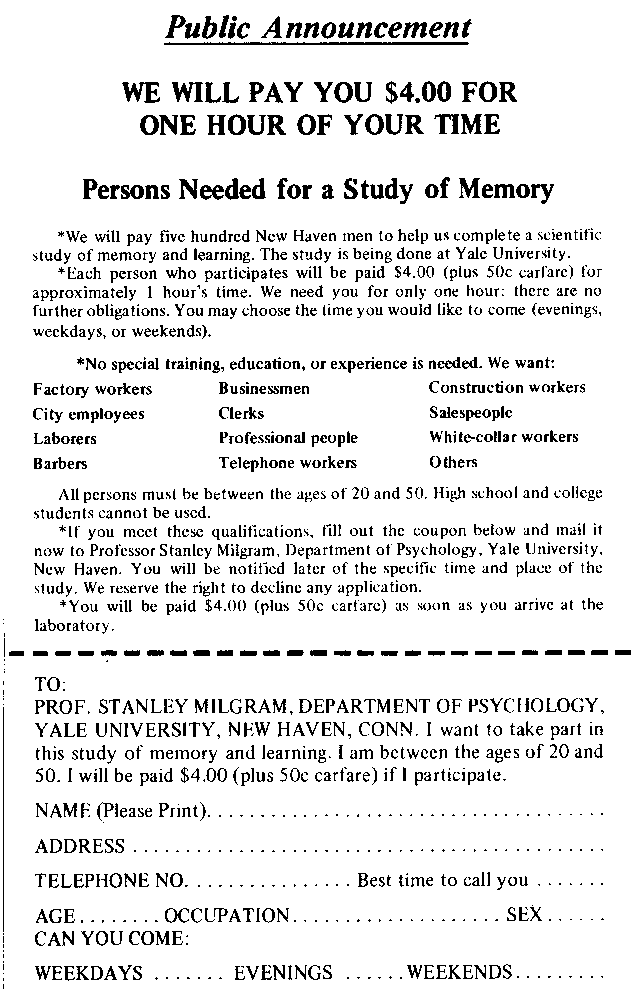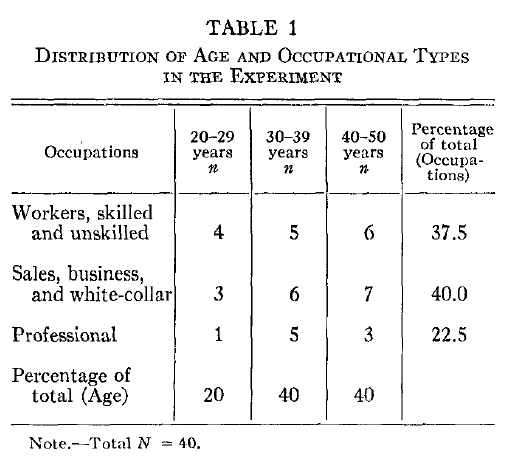
9

Stanley Milgram Obedience to Authority - experiments, study 1974
source link: http://www.age-of-the-sage.org/psychology/milgram_obedience_experiment.html
Go to the source link to view the article. You can view the picture content, updated content and better typesetting reading experience. If the link is broken, please click the button below to view the snapshot at that time.
Stanley Milgram on Obedience to Authority
Stanley Milgram, a psychologist at Yale University, conducted a
study focusing on the conflict between obedience to authority and personal
conscience.
The results of the study were made known in Milgram's
Obedience to Authority: An Experimental View (1974).
So-called "teachers" (who were
actually the unknowing subjects of the experiment) were recruited by Milgram in response to a newspaper ad
offering $4.00 for one hour's work.

In preparing to conduct his Study of Obedience Experiments Milgram selected 40 male volunteers who had responded to this advert for persons willing to participate in a Study of Memory.
The 40 who were chosen were selected to vary in age, educational attainment, and occupation to give an overall sample that was somewhat representative of the general population.

 Individual subjects thus recruited turned up to take part in a
Psychology experiment investigating memory and learning at Linsly-Chittenden Hall, (pictured left), on Yale University's
old campus. He introduced to a stern looking experimenter in a white coat
and to a rather pleasant and friendly co-subject who was also presumably recruited via
the same newspaper ad. The experimenter explained that one subject would be assigned the
role of "teacher" and the other would be assigned the role of "learner."
Individual subjects thus recruited turned up to take part in a
Psychology experiment investigating memory and learning at Linsly-Chittenden Hall, (pictured left), on Yale University's
old campus. He introduced to a stern looking experimenter in a white coat
and to a rather pleasant and friendly co-subject who was also presumably recruited via
the same newspaper ad. The experimenter explained that one subject would be assigned the
role of "teacher" and the other would be assigned the role of "learner."
Two slips of paper marked "teacher" were handed to the subject and to the co-subject. The co-subject was actually an actor who, in posing as a subject to the experiment, subsequently claimed that his slip said "learner" such that the unknowing subject was inevitably led to believe that his role as "teacher" had been chosen randomly.
Both learner and teacher were then given a sample 45-volt electric shock from an apparatus attached to a chair into which the "actor-learner" was to be strapped. The fictitious story given to the "teachers" was that the experiment was intended to explore the effects of punishment for incorrect responses on learning behavior.
A succession of unknowing subjects in their roles as teacher were given simple memory tasks in the form of reading lists of two word pairs and asking the "learner" to read them back and were instructed to administer a shock by pressing a button each time the learner made a mistake. It was understood that the electric shocks were to be of increased by 15 volts in intensity for each mistake the "learner" made during the experiment.
The shock generator that the "teacher" was told to operate had 30 switches in 15 volt increments, each switch was labeled with a voltage ranging from 15 up to 450 volts. Each switch also had a rating, ranging from "slight shock" to "danger: severe shock". The final two switches being labelled "XXX".

SHOCK GENERATOR, TYPE ZLB.
DYSON INSTRUMENT COMPANY,
WALTHAM, MASS.
The display indicated a shock output range of from 15 VOLTS - to - 450 VOLTS.

The above image is rather blurred so the following tabular data may be more convenient for gaining an appreciation of the range of controls at the "Teacher's"
disposal and as he or she acted under the implied authority of the experimenter.
Shock levels indicated during the Milgram Obedience Experiments
Shock Range Labelling Electric Shocks simulated
Slight Shock15 30, 45, 60 volts
Moderate Shock75 90. 105, 120 volts
Strong Shock135 150, 165, 180 volts
Very Strong Shock 195, 210, 225, 240 volts
Note the change from black to red text as the console display moves from :-
Very Strong Shock to Intense Shock and higher
Intense Shock 255, 270, 285, 300 volts
Extreme Intensity Shock 315, 330, 345, 360 volts
Danger: Severe Shock 375, 390, 405, 420 volts
and finally - XXX 435, 450 volts
The experiment was conducted in a scenario where the "learner" was in another room but
the "teacher" was made aware of the "actor-learner's" discomfort by poundings on the wall.
Shock levels indicated during the Milgram Obedience Experiments
Shock Range Labelling Electric Shocks simulated
Slight Shock15 30, 45, 60 volts
Moderate Shock75 90. 105, 120 volts
Strong Shock135 150, 165, 180 volts
Very Strong Shock 195, 210, 225, 240 volts
Note the change from black to red text as the console display moves from :-
Very Strong Shock to Intense Shock and higher
Intense Shock 255, 270, 285, 300 volts
Extreme Intensity Shock 315, 330, 345, 360 volts
Danger: Severe Shock 375, 390, 405, 420 volts
and finally - XXX 435, 450 volts
No further shocks were actually delivered - the "teacher" was not aware that the "learner" in the study was actually an actor who was intended, by the requirements of the experiment, to use his talents to indicate increasing levels of discomfort as the "teacher" administered increasingly severe electric shocks in response to the mistakes made by the "learner".
The experimenter was present in the same room as the "teacher" and whenever "teachers" asked whether increased shocks should be given he or she was verbally encouraged by the experimenter to continue.
These encouragements were, in fact, pre-scripted by the research team and followed this pattern:-
Prod 1: Please continue or Please go on.
Prod 2: The experiment requires that you continue.
Prod 3: It is absolutely essential that you continue.
Prod 4: You have no other choice, you must go on.
These Prods were to be deployed successively by the researchers - a higher number Prod could only be used if a lower number one had proved unsuccessful.
Each experimental session was terminated whenever Prod 4 failed to induce the "teacher" to continue administering electric shocks. In this scenario 65% of the "teachers" obeyed orders to punish the learner to the very end of the 450-volt scale! No subject stopped before reaching 300 volts!
At times, the worried "teachers" questioned the experimenter, asking who was responsible for any harmful effects resulting from shocking the learner at such a high level. Upon receiving the answer that the experimenter assumed full responsibility, teachers seemed to accept the response and continue shocking, even though some were obviously extremely uncomfortable in doing so.
In an article entitled "The Perils of Obedience" (1974) Stanley Milgram wrote:-
"Before the experiments, I sought predictions about the outcome from various kinds of people -- psychiatrists,
college sophomores, middle-class adults, graduate students and faculty in the behavioral sciences. With
remarkable similarity, they predicted that virtually all the subjects would refuse to obey the experimenter.
The psychiatrist, specifically, predicted that most subjects would not go beyond 150 volts, when the victim
makes his first explicit demand to be freed. They expected that only 4 percent would reach 300 volts, and that
only a pathological fringe of about one in a thousand would administer the highest shock on the board".
The Obedience to Authority experiment was continued by Milgram over a number of other scenarios such as
where the "learner" could indicate discomfort by way of voice feedback - at "150 volts", the "actor-learner"
requested that the experiment end, and was consistently
told by the experimenter that - "The experiment requires that you continue. Please go on." or similar words.
In this
scenarion the percentage of subjects who were prepared to administer the maximum 450 volts dropped slightly
to 62.5%Where the experiment was conducted in a nondescript office building rather than within the walls of a prestigiously ornate hall on Yale's old campus the percentage of subjects who were prepared to administer the maximum voltage dropped to 47.5%.
Where the "teacher" had to physically place the "learner's" hand on a "shock plate" in order to give him shocks above 150 volts the percentage of subjects who were prepared to administer the maximum voltage dropped to 30.0% and where the "experimenter" was at end of a phone line rather than being in the same room the percentage of subjects who were prepared to administer 450 volts dropped to 20.5% and where the "teacher" could himself nominate the shock level the percentage of subjects who were prepared to continue to the end of the scale dropped to 2.5%
Milgram summed up his findings in relation to the main experiment in "The Perils of Obedience" (1974):-
"The legal and philosophic aspects of obedience are of enormous import,
but they say very little about how most people behave in concrete situations.
I set up a simple experiment at Yale University to test how much pain an
ordinary citizen would inflict on another person simply because he was ordered
to by an experimental scientist. Stark authority was pitted against the
subjects' strongest moral imperatives against hurting others, and, with the
subjects' ears ringing with the screams of the victims, authority won more
often than not. The extreme willingness of adults to go to almost any lengths
on the command of an authority constitutes the chief finding of the study and
the fact most urgently demanding explanation."

She found that whilst Milgram's originally published article mentioned some forty participants, of which some twenty-six proved to be obedient, some seven hundred naive participants were actually "tested" in various experimental scenarios with varying results as to their "obedience".
Some of those being tested reported doubts about the credibility of the scenario they were involved in - voice feedback from "punished" learners seeming to come from a loudspeaker high on a wall rather than from a slightly open door to a room where they were given to understand the "learner" was.
Others seemed to sense that they - as teachers - were under the close scrutiny of the experimenter rather than the learner.
There were instances of the experimenter going beyond the stated four pre-scripted encouragement prompts to the point of being a degree of harassment or bullying in efforts to ensure obedience.
It has also been pointed out that in the original Yale University scenario "teachers" could see themselves as being under the moral guidance of a scientifically qualified employee of a respected academic institution and to take decisive cues from the "experimenters" evident impassivity in the face of the "learners" protests.

Check out this web page:-
Recommend
About Joyk
Aggregate valuable and interesting links.
Joyk means Joy of geeK